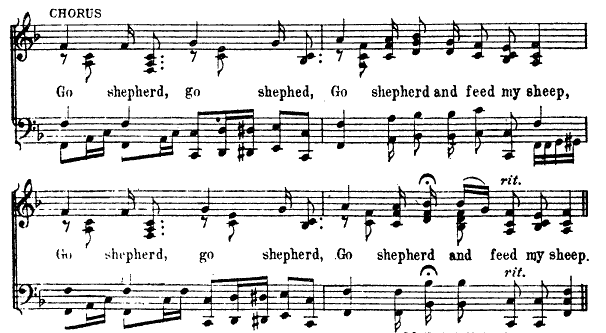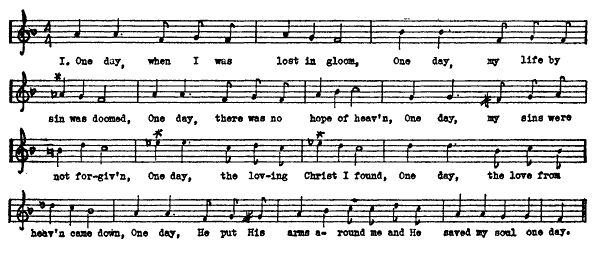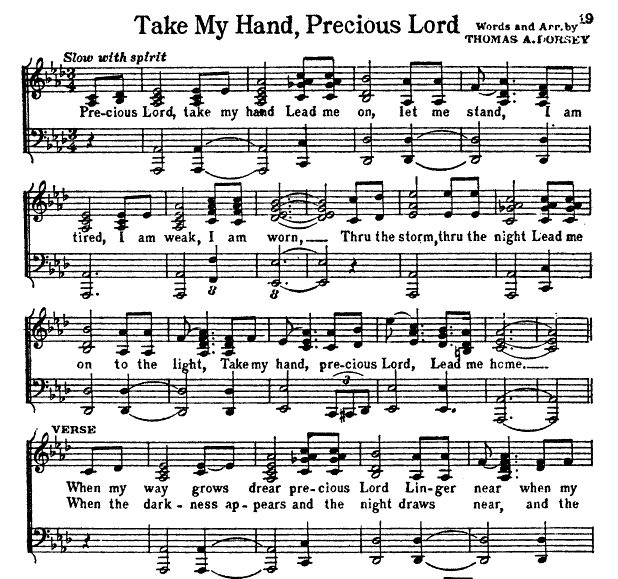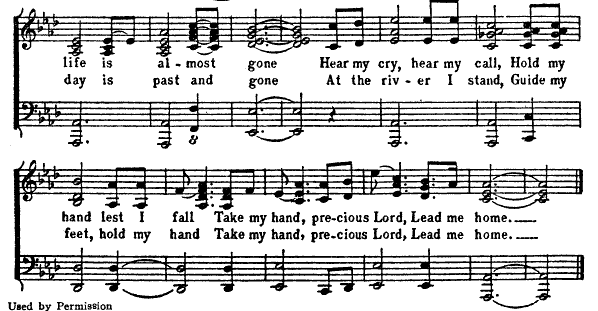Changing Patterns in Negro Folk Songs by John W. Work
The Journal of American Folklore, Vol. 62, No. 244 (Apr. - Jun., 1949), pp. 136-144
CHANGING PATTERNS IN NEGRO FOLK SONGS*
By JOHN W. WORK Fisk University, Nashville, Tennessee
[* Paper delivered at the nineteenth annual Fisk Festival of Music and Art, Nashville, Tennessee, April 29-May 1, I948.]
A FEW YEARS AGO, an article appeared in the Saturday Evening Post by Ravenel Sass, an old-line South Carolinian, on the lamentable passing of the Negro spiritual from the American scene. ["I Can't Help from Crying," Saturday Evening Post, October 3, 1942.] Mr. Sass strongly deplored the intrusion of hymn books into the Negro church service, for in their use he saw the doom of what he regards as "one of the distinctive things that America has produced." In his article Mr. Sass reveals his deep and tender affection for the spiritual. Further, we gather from his writing that he has listened enthralled to the South Carolina manner of rendering these songs throughout his life, as did his forebears, generations before him. He implies, by references, high commendation for the Society for the Preservation of the Spirituals, an organization founded by white landowners, in and around Charleston, for its efforts to preserve these spirituals in their original form. Now, Mr. Sass's article is not unique. Many such articles have been written even before the one by Mr. Sass, all deploring the gradual disappearance of this wonderful musical folk form. Any person who has been stirred by the spirited singing of a folk congregation's rendering of "Rock Mt. Sinai," "I'm Working on the Building," or "When the Gen'l Roll is Called" must join with these writers in hoping that such singing will never be allowed to pass away.
But that style of singing and type of song have nearly disappeared; however they have not entirely passed away. They have only passed over into another type of singing and song. A visitor to southern Negro folk churches will hear much interesting music. Some of the music will be from the traditional hymnody. Occasionally, traditional spirituals will be heard, especially on Communion and Covenant Sundays. And, "Dr. Watts" are still being sung. But he will hear also some exciting, new music which possibly will disturb him. In this new music there are some striking phenomena to be observed.
Most noticeable of course are the instrumental accompaniments which are being added to the singing of today. These accompaniments are just as integral a part of the performance as is the singing, and in a like manner equally an expression of the folk. Such accompaniments must not be confused with accompaniments provided in concert-performance arrangements of spirituals which are currently more familiar. This latter type of accompaniment is academically conceived and stems from the classroom. The concert arrangement which is heard today is stiff and formal, and bears little relation to the style and feeling of the song itself. This has given rise, and justly so, to protests against such arrangements on the part of many folklorists and art musicians. The folk do not like these arrangements themselves. Once, when I performed an arrangement of a spiritual for a folk singer from whom I had learned the spiritual in question, he told me that he did not like my arrangement because it was too "pretty." This was the first time that it had occurred to me that in their original performances, spirituals were not "pretty." Grand, majestic, moving perhaps, but never "pretty."
In the older, more fundamental Negro churches, not only were instruments not permitted in the service, but the members were strictly forbidden to play them in activities outside of the church. Almost every serious collector of folk songs has at some time encountered a famous fiddler or banjoist, now a member of the church, who refused to play the instrument because of the religious ban against it, although in telling about it he would cast a wistful eye toward the instrument. Often, older players are encountered who have not become members of the church because they would not abandon their instruments as required.
This ban on instruments by the folk church is not to be confused with their exclusion from the worship service of the Church of Christ. The Church of Christ does not forbid its members from playing instruments outside of the church, but eliminates it from the service because of a strict interpretation of certain biblical passages. The folk church has forbidden instruments to be used in the service in the past apparently because the instruments available in the community, the piano, the guitar, harmonica, and the banjo were too closely identified with secular life-or "the world," as opposed to the sacred the church.
In the absence of instruments, a type of music evolved in these churches independent of an instrumental concept. The older type of spiritual is a case in point. In truth, in many of these churches there are types of music being sung in which the use of accompanying instruments would be entirely out of place. For example, we can cite the "old" long meter hymn, [The use of "long meter" here is not to be confused with the term used in standard hymnology. The folk using the term refer to a very slow tempo instead of poetic syllables.] frequently called "Dr. Watts."
The first instruments to invade the folk church service were the piano and the melodeon. The use of these instruments was undoubtedly handed down from the middle class churches through the pressure of travelling evangelists. The Mefhodist Church probably supplied the opening wedge because the Methodist hymnology did not include the old [2] long meter "Dr. Watts" which today, and for many decades in the past, has been the exclusive property of the Primitive Baptist Church and the marginal Missionary Baptist Church. The folk churches of the Methodist denomination have relied on the hymnal in their worship services more generally than have those churches of the Baptist denomination. Customary reliance upon instrumental support for the performance of these hymns made the appearance of the piano and melodeon in the churches a welcome one. At this point it would be well to define more fully the divisions of Baptist Church for a clearer understanding of the ensuing discussion.
The divisions in the folk Methodist Church are largely organizational, with little difference in doctrine. But there are rather distinctive divergences in beliefs and practices within the Baptist Churches. While there are several minor groups of Baptists, they fall generally into two large denominations: Missionary Baptists and Primitive Baptists. The Missionary Baptist Church is the larger denomination, spreading as it does throughout the country. It serves as a folk church, as a middle class church, and as the church for intellectuals. Hoping to avoid a doctrinal controversy, I will state as succinctly as possible that this church's practices and beliefs center around immersion, the independent clergy, and closed communion. For the purposes of our discussion we might say that this is the book-reading and piano-playing church, and yet one in which old "Dr. Watts" are frequently sung.
But, as students of folklore, the Baptist Church in which we have the more interest is the Primitive Baptist Church, variously called the "Old Baptist" or "Hard Shell" Baptist Church. These Baptist Churches are usually small and are found mostly in the rural south. The practices and beliefs include, in addition to those of the Missionary Baptists, footwashing and predestination. This church, as I have indicated earlier, is the real home of the old "Dr. Watts." Mr. Sass, whose article we have referred to, deplores the passing of the spiritual, but I personally grieve much more over the passing of this "Dr. Watts." There is something epic, something elemental, something overwhelmingly religious about the rendition of these old songs. Starting softly and informally, as one of them does after the half-intoned wordphrase by the leader, a melody is spun-out melismatically with no rhythm derived out of measure and beat, only punctuated by the wordphrase of the leader. The crescendo is gradual but relentless, and at a high point in the song the membership rises and engages in a very dignified formal clasping of hands between members right and left. Sometimes the singers, particularly the deacons, circulate among the membership. There is nothing trite, banal, or sensational in this performance.
There seems to be no musical descendant of this grand old song type. Certainly no art form has embraced it or derived anything from it. The great American composer, R. Nathaniel Dett, attempted to incorporate something of this long meter in "Chariot Jubilee," one of his most ambitious choral works. There is a melismatic flavor characterizing the singing style of Negro folk today which may very well be derived from these earlier "Dr. Watts." This Baptist Church is, or was until about fifteen years ago, one which conducted its services without hymn books or instruments. In cities and sections other than in and around Nashville it may still continue this practice.
Consternation reigned among the faithful when the famous Primitive Baptist Church in Nashville, shepherded by the Reverend Zema Hill, organized a choir, adorned it in robes, and added to it a "rhythmic piano." This change took place about twelve years ago. To many, such an innovation was dark heresy. Reverend Hill, when asked the question "why did he do it?" explained that the demand for such music on the part of the young members of his church became so insistent that he was forced to accede to it. The success of the experiment was much greater than Reverend Hill had anticipated. The young people entered into the singing and the church service with a spirit and enthusiasm they had never evinced before. Now, there are more choir members marching in the processional in his church on Sunday night than many similar churches number in their entire congregations. The protest against this different kind of music on the part of the older members was vigorous at first, but it has since died down to the merest grumble. Other Primitive Baptist Churches in Nashville took immediate notice of the strong appeal which these accompanied songs had for the young people, and most of these churches have since organized choirs and introduced the rhythmic piano.
Returning to the discussion of the type of accompaniment which now has invaded most of the folk churches, it can be seen even on casual study that it is based entirely upon prevailing community folk idioms. There is very little variance in the types and styles of accompaniment within any given community. The skill in performance, facility, and the different ranges of emotional intensity of individual instrumentalists offer such variations as are generally recognizable only to persons familiar with the music and performers in any particular section. The accompaniment, as played by any performer varies very little from song to song with respect to his individual style. Because the written note is a negligible factor in the instrumentalists' performance scheme, the performance itself is improvisation. Thus the performance is essentially an aggregation of idioms.
Such instrumental music-with the exception of that performed by the fiddle-exploits melody to a small degree only. Contrapuntal fragments do occur. But the original folk song melody is of secondary importance in these instrumental performances. Instead, the basic elements are harmonic figuration and rhythmic patterns. These elements change radically as time goes by. The harmonic figuration becomes increasingly complex and involved.

This equally applies to the rhythmic patterns. Hence, we observe a process of evolution from the simple, earlier style to something that requires a highly proficient executant. An idea of the prominence of the rhythmic element in the new folk church music may be gained from observing the following musical excerpt. It must be noted, however, that this written example is a very simple one indeed, rhythmically, when compared with those intricate patterns which characterize the actual, improvised performance by skillful pianists who ignore notation.
In some congregations more instruments than a piano are used in accompanying the singing. Frequently one hears with some amazement a guitar. Sometimes a saxophone, a trombone, and a violin may be heard. Tambourines are almost always present in the worship services of one particular denomination. The principal percussion is provided, however, by handclapping on the part of the congregation off the beat. Three or four hundred pairs of hands beating in unison can produce a rhythmical impact which is astounding.
In discussing the instrumental ensemble just described, which has been incorporated into the folk church service, we leave the Baptist Church and begin the study of the church which has made such unusual use of it, the Holiness Church, known variously by different names: the Church of God, or the Sanctified Church. This church is a phenomenon of twentieth-century folk-worship. Apparently, the Holiness movement started about the turn of the century. Many persons can recall the first appearances in their communities of these churches. Since, their number have grown and multiplied amazingly. The worship service in this church is unique. Music is exploited to a degree that probably is not attained in any other denomination. While the churches of other denominations may be said to be minister-centered, the Holiness Church differs in that it is congregation-centered. In the latter church the free participation by all members gives to its service a distinctive character, and is strikingly in contrast to the service in other churches. In its employment of the instrumental ensemble the Holiness Church embraced with open arms this heretofore forbidden medium of intensive rhythm, used before only in secular folk music, while the Primitive Baptist Church merely gave it a timid handshake. This union of secular and religious folk musical forces has without question led to a result of significance. Martin Luther is supposed to have said four hundred years ago "The devil has no business with all the good tunes." Elder Gray, one of the patriarchs of the Holiness Church just a few years ago repeated these same words with a minor variation: "The devil should not be allowed to keep all this good rhythm." And, he has not. He is in danger of losing it to the musicians of the Holiness Church. Both instrumentalists and congregational participants have developed a rhythmic intensity possibly unequalled in any prior musical performance. These combined forces under prolonged religious excitation frequently extend the length of a song by as much as six minutes, and even more beyond its normal singing time. The active participation of hundreds of church members together with the instrumentalists develops a degree of rhythmic intensity which cannot be matched by any dance band. Today, this characteristic instrumental rhythm is the second striking new element to be noticed in performances of Negro religious folk music. For generations the syncopation and percussive instrumental rhythms have been identified solely with secular music. But this is no longer true.
Concomitant with the appearance of this intensive instrumental rhythm has been one of the most unusual innovations in the religious ritual in America- the religious dance. The use of the dance as an integral part of a religious service has for centuries been contrary to European tradition, although the dance has been associated with religious worship in other sections of the world. The dance in the worship service of this church has stimulated a degree of religious exhaltation not observed in other churches of America. A large number of the songs used in the Holiness Church service are traditional spirituals, but such songs are so often distorted because of their rhythmic accompaniment, they frequently are recognized only with difficulty.
A few new spirituals created in the traditional molds are today being added to the Holiness repertory, mainly because of the practice of the church which gives its members a free opportunity to lead songs in the praise service. A third innovation noticeable currently in the music of the Negro folk church is a type of song more similar to the conventional gospel song in its verse form, than to the traditional spiritual. In the main, these songs are either sixteen or thirty-two measures in length. They are generally accompanied. This song type dominates the services of the Missionary Baptist and Holiness Churches, while increasingly invading the service of the Primitive Baptist Church. A purist hearing such a song would exclaim "That is no spiritual; it is a gospel song." A member of one of the folk churches would call it a "Dorsey."
These "Dorsey" songs are copyrighted and are issued in printed form. Their sale is gradually approaching "big business" proportions. There are now several firms devoted to their publication almost exclusively. Since the form of these songs is somewhat similar to the more familiar evangelical songs of the nineteenth and early twentieth centuries, they can undoubtedly be called "gospel songs." But there are some other characteristics of this type of song and some sociological factors connected with it which indicate that the term "gospel song" is not entirely adequate.
The first of these factors is the demonstrable fact that this "Dorsey" song is composed by the identical people who formerly created the spiritual and is composed for the same people who used to worship by the spiritual-the Negro folk. They are created in folk fashion, that is, one person composes words and music simultaneously as one single creative act. The fact that the song is published need not be too disturbing to anyone with the traditional concept of a folk song. Publication and copyright facilities were unknown to the folk creators of earlier times. Now these folk composers rush to the press with their songs. No longer can the folklorist, or serious composer publish safely an unfamiliar spiritual he may have "collected" in some out-of-the-way rural place. Today there is a good chance that it is published and copyrighted by its composer.
A second differentiating characteristic of these songs is the close kinship of their melody with that of the older spiritual and blues. The flatted seventh and third [3] occasionally found in the spiritual and a regular feature of blues melodies, are frequently found in these melodies or accompaniments. Because of these notes and their melodic patterns it would be an easy matter to confuse some of these songs with those in the secular life if the words were omitted. Observe the following example.
ONE DAY- Words and Music by Kenneth Morris

The name "Dorsey" by which these songs are called is given to them because one man, Thomas A. Dorsey, wrote such distinctive songs in this style. He is one of the most unusual music creators in the country today. In his interesting biographical sketch of Dorsey, Arna Bontemps accounts for the secular character of his music and his interest in the piano accompaniment. [4] With a rural Georgia background, he was a piano player in dance bands in the 'twenties. Among those whom he accompanied for a long time was "Ma" Rainer the famous pioneer blues singer. He now operates a prosperous music publishing firm in Chicago.
But while Mr. Dorsey brought to the religious songs rhythmic and melodic patterns taken from the secular world, he nevertheless brought also an intense religious devotion to them. In his autobiography [5] Dorsey reveals the bitter struggle in his life between things worldly and those sacred, with the final victory being won by the church. He tells of composing his famous song "Precious Lord Take My Hand" the day after a bitter tragedy had shaken his life.
[3] Those who would like to study this subject further are referred to the following sources:
W. C. Handy and Abbe Niles, Blues: An Anthology (New York, 1926), pp. 22-24; Henry Krehbiel,
Afro-American Folk Song (New York, I914), pp. 70-9I; John W. Work, American Negro
Songs (New York, 1938), pp. 26, 33-35.
[4] "Rock, Church, Rock," Common Ground, Vol. 8, No. I, 1942.
[5] Thomas A. Dorsey, Songs with a Message, with My Ups and Downs (Chicago, I941).


Miss Lucie Campbell of Memphis, Tennessee, Mrs. Lillian Bowles and Kenneth Morris, both of Chicago, are other writers whose songs enjoy wide spread use. There are still several other writers in this field who have an extensive following.
Instruments, intensive rhythm, and the "Dorseys" have not invaded the church service without bitter opposition. Many preachers abhor them, but tolerate them only because of the tremendous stimulation which they bring to the church service. Regardless of such opposition, this type of religious folk music will continue to be used, and even enjoy a greater popularity in time to come. The folk felt a stirring need for a new music. They are busy creating it.